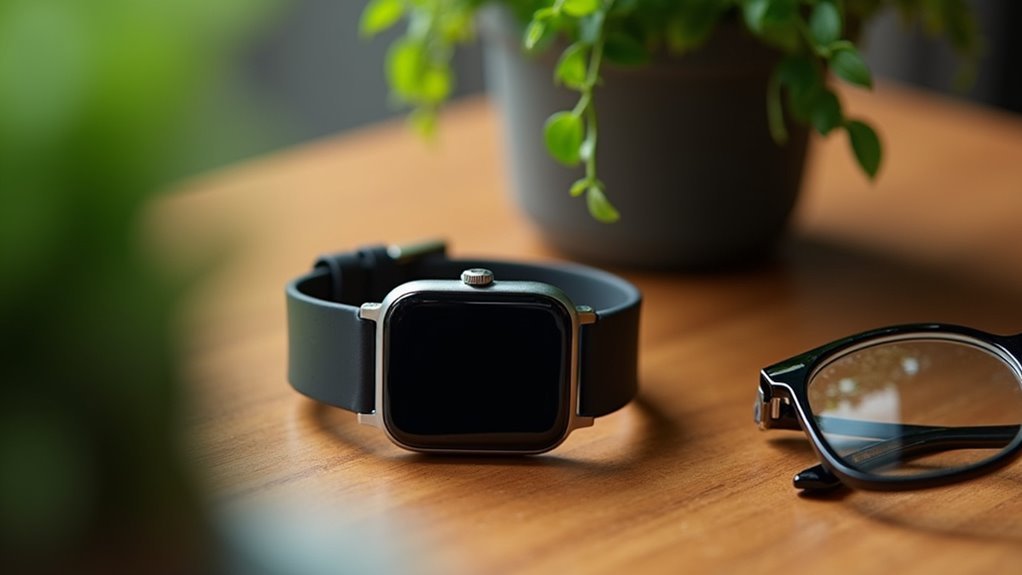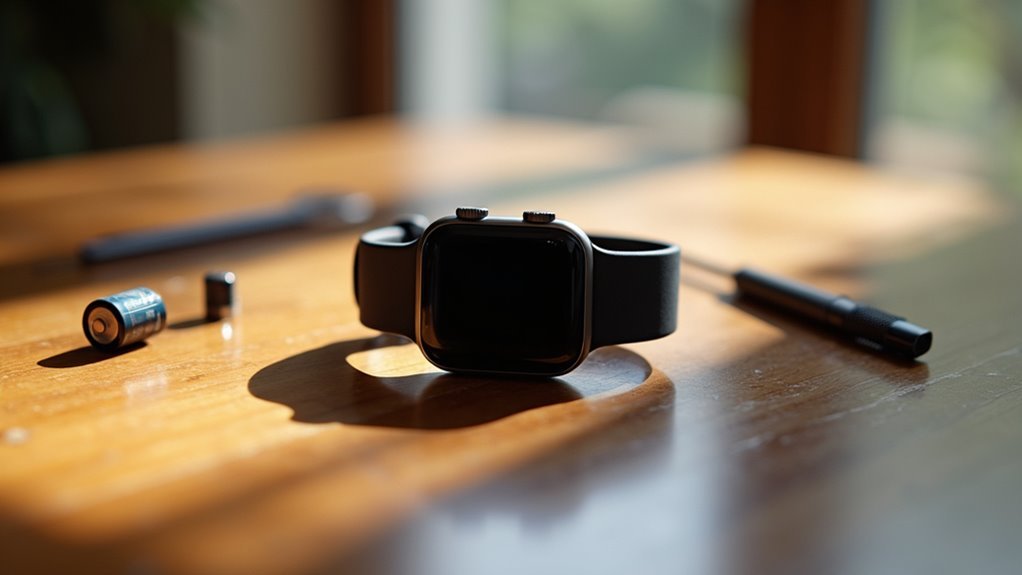You can dramatically extend your wearable oxygen tracker’s battery life by switching from continuous to manual monitoring when clinically appropriate, optimizing power settings like lowering screen brightness and disabling GPS, choosing rechargeable lithium batteries with proper charging habits, turning off non-essential features like Bluetooth when not syncing, and implementing power-efficient usage patterns through duty cycling between active and sleep modes. These strategic adjustments will help you discover additional advanced techniques for maximizing your device’s performance.
Switch From Continuous to Manual Oxygen Monitoring

While continuous oxygen monitoring offers superior clinical outcomes, switching to manual monitoring can significantly extend your wearable oxygen tracker’s battery life.
Manual monitoring reduces your device’s power consumption by eliminating constant data collection and transmission. You’ll avoid the costs of continuous monitoring while reducing technology dependence and maintenance requirements.
Manual monitoring cuts power usage by stopping constant data collection while reducing costs, tech dependence, and maintenance needs.
However, this approach requires trade-offs. You’ll need to perform more frequent manual checks, increasing your workload and potential for human error.
Manual monitoring provides only sporadic data collection, making oxygen level regulation less precise than automated systems. You’ll collect basic feedback on oxygen levels, but you’ll miss the superior target range maintenance that continuous systems provide. Studies show that automated oxygen systems keep patients within target SpO2 ranges for 87% of the time compared to 60.6% with manual monitoring.
Consider your specific needs, training requirements, and monitoring frequency before making this switch.
Optimize Power Settings and Low-Energy Features
Since your wearable oxygen tracker’s battery performance directly impacts its reliability, optimizing power settings becomes essential for extended monitoring sessions.
Your device offers several built-in features that considerably reduce power consumption without compromising core functionality.
Start by activating your tracker’s dedicated power-saving mode, which automatically limits background processes and reduces screen activity.
Next, disable unnecessary features like GPS location tracking and vibration alerts when you don’t need them.
You’ll also want to lower your screen brightness and enable quick timeout settings.
Here are three key adjustments that’ll maximize your battery life:
- Set data updates to less frequent intervals during non-critical monitoring periods
- Use Wi-Fi instead of cellular data for syncing when possible
- Store measurement data locally before bulk transmission to your smartphone
These simple tweaks can extend your device’s runtime considerably. Most quality oxygen monitors feature 12-16 hours of continuous operation on a single charge, giving you flexibility in your monitoring schedule.
Choose the Right Battery Type and Manage Charging Habits

Your battery choice forms the foundation of reliable oxygen monitoring, making it essential to understand which type best suits your tracking needs.
Rechargeable lithium batteries offer the best combination of high capacity and longevity for wearable devices. LiFePO4 batteries provide exceptional safety with up to 2,000 charge cycles, while LiPo batteries deliver high energy density perfect for compact wearables.
Consider your device’s voltage requirements, typically ranging from 1.5 to 3 volts.
Proper charging habits extend battery life considerably. Charge regularly without letting your device fully discharge, and avoid overcharging by using chargers with built-in protection.
Charge in moderate temperatures and maintain scheduled charging intervals. Periodically calibrate your battery by allowing complete discharge before recharging to improve tracking accuracy. Store your wearable oxygen tracker in a cool, dry place when not in use to prevent unnecessary battery drainage and maintain optimal performance.
Disable Non-Essential Device Features
Although oxygen monitoring remains your device’s primary function, numerous background features continuously drain battery power without contributing to your health tracking goals.
You can greatly extend your tracker’s battery life by selectively disabling unnecessary features through your device settings.
Review these battery-draining features for potential disabling:
- Location Services – Turn off GPS tracking when you don’t need location data for your workouts, as constant positioning updates consume substantial power.
- Bluetooth Connectivity – Disable when you’re not syncing data or using connected features, since maintaining wireless connections requires continuous energy.
- Motion Sensors – Reduce step counting and gesture recognition when focusing solely on oxygen monitoring.
Enable features only when needed, and regularly review app permissions to prevent unnecessary sensor usage during your health tracking sessions. Modern wearables like the Masimo W1 typically offer up to 24 hours of continuous operation when properly optimized.
Implement Power-Efficient Usage Patterns
When you strategically adjust your oxygen tracker’s operational patterns, you’ll greatly reduce power consumption while maintaining accurate health monitoring.
Implement duty cycling by switching between active, listen, and sleep modes throughout the day. You can optimize measurement intervals by reducing how frequently your device checks oxygen saturation levels—consider extending intervals during inactive periods.
Switch your oxygen tracker between active and sleep modes throughout the day to optimize measurement intervals and reduce power consumption.
Set up user-driven scheduling that adapts to your activity patterns. During sleep, your tracker doesn’t need constant monitoring, so program longer intervals between readings.
Utilize low-power modes when you’re sedentary or sleeping.
Optimize signal processing algorithms to reduce computational load without sacrificing accuracy. Advanced change point detection can identify when your activity levels shift, allowing your device to automatically adjust monitoring frequency and achieve substantial energy savings.
Frequently Asked Questions
How Do Extreme Temperatures Affect My Wearable Oxygen Tracker’s Battery Performance?
Extreme heat accelerates your battery’s chemical degradation, causing faster aging and unexpected shutdowns. Cold temperatures temporarily reduce capacity and increase resistance, making your device drain quicker and potentially power off unexpectedly.
What’s the Difference Between Li-Ion and Other Battery Types for Oxygen Trackers?
Li-Ion batteries offer higher energy density but shorter lifespan than LiFePO4. You’ll get more power per weight with Li-Ion, while LiFePO4 provides better safety and longevity for your tracker.
How Often Should I Update My Device’s Firmware for Better Battery Life?
You should check for firmware updates quarterly and install them when available. Regular updates optimize power management algorithms, improve sensor accuracy, and include battery-saving features that can extend your device’s battery life considerably.
Can Using Bluetooth Low-Energy Instead of Regular Bluetooth Extend My Battery Life?
Yes, you’ll greatly extend your battery life by using Bluetooth Low Energy instead of regular Bluetooth. BLE consumes much less power, transfers data efficiently in short bursts, and keeps your device sleeping longer.
How Do I Check if My Oxygen Tracker’s Battery Health Is Declining?
You’ll notice shorter usage time between charges, unexpected shutdowns, or longer charging periods. Check your device’s app for battery health reports, monitor rapid power drops during use, and watch for overheating symptoms.
In Summary
You’ll dramatically extend your wearable oxygen tracker’s battery life by switching to manual monitoring when continuous tracking isn’t necessary. Optimize your device’s power settings, choose quality batteries, and maintain proper charging habits. Disable features you don’t use regularly and develop power-conscious usage patterns. These simple adjustments will keep your device running longer between charges, ensuring you’ve got reliable oxygen monitoring when you need it most without constant battery anxiety.





Leave a Reply